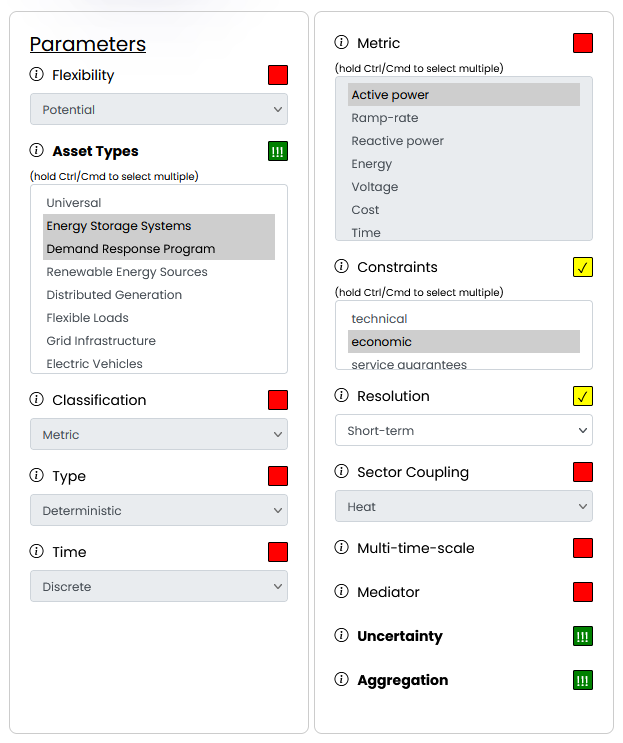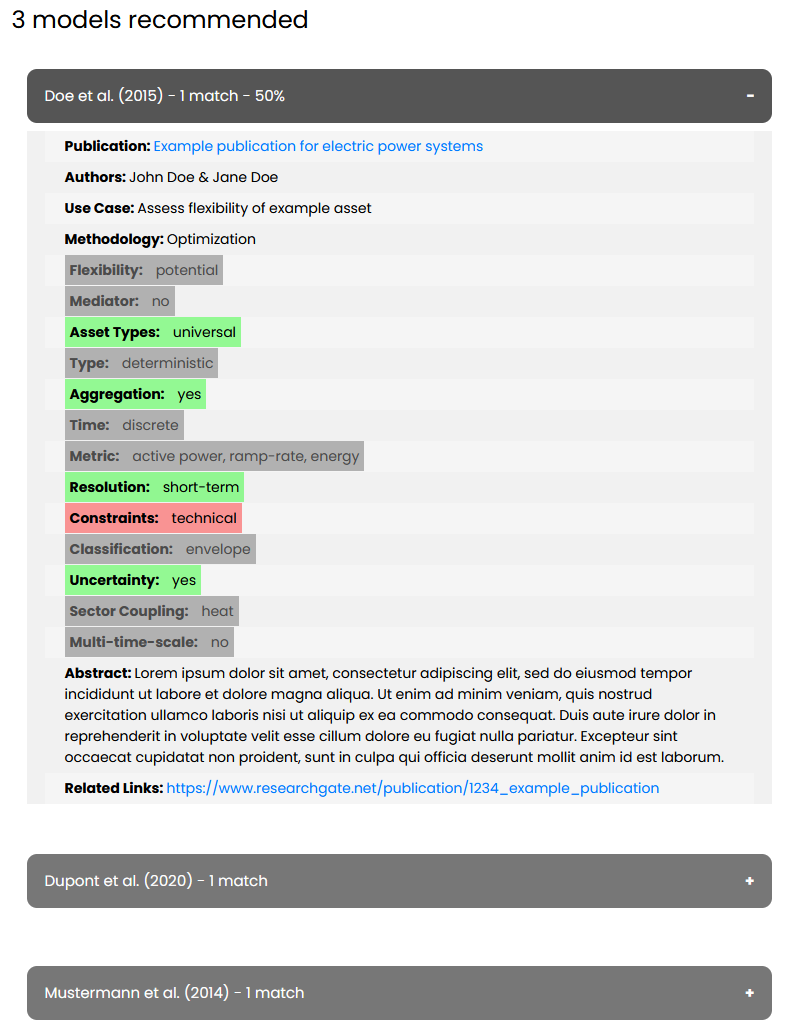▼ Using the Flexibility Model Recommender: A Step-by-Step Guide
To demonstrate how to use the Flexibility Model Recommender, we will walk through a sample
scenario
step by step. This example illustrates the selection process and filtering workflow, making it
easier to understand how the tool helps identify suitable flexibility models based on specific
needs.
To develop a model, the first step is defining the important parameters specific to the VPP. These parameters will guide your model selection or development process. Some of the key parameters would be:

Using the three-way checkboxes next to each parameter, we categorize them as mandatory, desired, or irrelevant for our VPP scenario.
In the following, we derive a selection of relevant parameters from the initial set of important criteria, based on the available options in the recommender. To illustrate its use, we emphasize certain aspects while intentionally omitting others, without claiming that this represents the optimal parameter choice for the given VPP scenario.


Clicking on any model in the results expands it to reveal more details.
Example of a possible result:

For a comprehensive overview of all available models and their details, navigate to the Models tab.
Example scenario
A Virtual Power Plant (VPP) aggregates multiple small-scale flexibility resources (such as residential batteries and industrial demand response participants) to enhance grid stability while managing uncertainties in renewable energy generation.To develop a model, the first step is defining the important parameters specific to the VPP. These parameters will guide your model selection or development process. Some of the key parameters would be:
- Resource Types: What are the flexibility resources? (e.g., residential batteries, industrial demand response)
- Uncertainty Handling: How will the model address renewable energy variability? This might involve probabilistic forecasting, storage management, and demand-side adjustments.
- Grid Stability: What specific grid stability measures need to be incorporated, such as frequency regulation or balancing load in real-time?
- Optimization Goals: What are the optimization objectives of the VPP? (e.g., minimizing costs, maximizing energy efficiency, balancing supply and demand, ensuring stability)
- Time Horizon: How quickly must decisions be made? (e.g., real-time or over a longer planning horizon)
- Economic Factors: Are there any constraints around cost or financial optimization, or is it primarily focused on stability?
Step 1: Exploring Parameter Options
Before selecting parameters, we familiarize ourselves with the available choices:- The Parameter Explanation article on the Help page provides an overview.
- Alternatively, clicking the information icon next to each parameter within the Flexibility Model Recommender opens a popover with a description.
Step 2: Selecting Parameters for the Scenario
Next, we navigate to the Flexibility Model Recommender and define our selection:
Using the three-way checkboxes next to each parameter, we categorize them as mandatory, desired, or irrelevant for our VPP scenario.

In the following, we derive a selection of relevant parameters from the initial set of important criteria, based on the available options in the recommender. To illustrate its use, we emphasize certain aspects while intentionally omitting others, without claiming that this represents the optimal parameter choice for the given VPP scenario.
Parameters (Strictly Required)
- Demand Response Programs (Asset Type) → The VPP includes demand-side participants that adjust consumption based on market signals.
- Energy Storage Systems (Asset Type) → Distributed batteries are used to store excess energy and discharge it when needed.
- Uncertainty → The VPP must handle fluctuations in renewable generation and demand variations.
- Aggregation → The model must support grouping multiple smaller flexibility resources into a unified entity.
Parameters (Preferred but not mandatory)
- Short-term Resolution → The VPP operates in real-time and short time frames, so models with short-term decision-making are beneficial.
- Economic Constraints → The VPP aims to optimize financial outcomes but does not make it an absolute requirement.
Irrelevant Parameters (Not considered)
- Other parameters are not relevant to this example.

Step 3: Adjusting Match Requirements
We now define the minimum number of desired parameters a flexibility model must meet.- In this example, we set the value to 1, meaning at least one of our desired parameters must be present.
- Setting this value to 2 would require both desired parameters to be included, effectively making them mandatory.

Step 4: Retrieving Matching Models
Finally, we click the "Show Models" button, and the recommender generates a list of flexibility models that best match our selected parameters, displaying the most relevant options first.Clicking on any model in the results expands it to reveal more details.
Example of a possible result:

Conclusion
By following this process, you can efficiently use the Flexibility Model Recommender to identify models that best suit your specific needs, ensuring a streamlined selection process for various flexibility scenarios.For a comprehensive overview of all available models and their details, navigate to the Models tab.
▼ Parameter Explanation
Flexibility
- Flexibility Potential: Represents the capability of flexibility resources (like energy storage, demand response) to adjust their power output or consumption, providing essential services like energy supply or demand balance.
- Flexibility Requirement: Refers to the overall needs of the power system for flexible resources to maintain stable operations and adapt to variability, such as that from renewable energy sources. This quantifies the adjustments necessary across the system to ensure reliability and prevent disruptions.
Asset Types
- Energy Storage Systems: Such as batteries, pumped hydro storage, and compressed air energy storage, which can absorb excess power during low demand and release it during peak demand.
- Demand Response Programs: These involve adjusting the demand side of consumption, where consumers reduce or shift their electricity use in response to market signals or utility requests.
- Renewable Energy Sources: Like wind turbines and solar panels, which are inherently variable and require flexible solutions to integrate their output smoothly into the grid.
- Distributed Generation: Including small-scale units like diesel generators, microturbines, and combined heat and power (CHP) systems that can be controlled to help balance local demand and supply.
- Flexible Loads: Industrial processes, heating and cooling systems, and other energy-intensive operations that can be adjusted in real-time to help balance the grid.
- Grid Infrastructure: Advanced transmission technologies, including smart grids and dynamic line rating systems, that can adapt to changing conditions and manage flows more effectively.
- Electric Vehicles (EVs): Their charging and discharging can be managed to provide flexibility, particularly as the prevalence of EVs continues to increase.
- Interconnectors: High voltage lines connecting different regions or countries, allowing for the transfer of electricity across borders, which can be used to balance regional differences in demand and supply.
- Peaking Power Plants: Typically gas turbines or hydro plants that can be ramped up quickly to meet sudden increases in electricity demand or unexpected drops in renewable generation.
Classification
- Metric: Uses predefined parameters to either deterministically quantify flexibility without considering uncertainties or Measures the likelihood of various flexibility scenarios using statistical methods.
- Machine Learning Model: Employs machine learning techniques to predict and optimize flexibility based on historical data.
- Envelope: Defines the operational boundaries or limits within which flexibility can be effectively measured or maintained. This includes the range of acceptable inputs, outputs, and constraints on flexibility metrics or predictions.
Classification Details
- Time Series - Cumulative: Analyzes flexibility over a period by aggregating data to show cumulative potential or requirements.
- Time Series - Non-Cumulative: Examines flexibility potentials or requirements at specific times without accumulating data over time.
- Set - Interval: Represents flexibility within set boundaries defined by minimum and maximum values at a specific time.
- Set - Polytope - Single-Time-Step: Defines flexibility as a geometric shape in a multidimensional space at a single time step, capturing constraints and capabilities.
- Set - Polytope - Multi-Time-Step: Extends the single-time-step polytope model to cover multiple time steps, providing a broader view of flexibility over time.
Type
- Deterministic: Using specific, fixed parameters and conditions to calculate flexibility needs and potentials. These models operate under the assumption that all inputs (such as demand forecasts, generation capacity, and operational constraints) are known and remain constant, leading to predictable and consistent outcomes.
- Probabilistic: Accounting for the uncertainty inherent in energy systems by using probability distributions and stochastic processes to determine flexibility requirements and resources. These models consider variations in input data like renewable energy output, consumer demand, and equipment failures, providing a range of possible outcomes rather than a single deterministic result.
Time
- Discrete: Using specific, fixed parameters and conditions to calculate flexibility needs and potentials. These models operate under the assumption that all inputs (such as demand forecasts, generation capacity, and operational constraints) are known and remain constant, leading to predictable and consistent outcomes.
- Continuous: Accounting for the uncertainty inherent in energy systems by using probability distributions and stochastic processes to determine flexibility requirements and resources. These models consider variations in input data like renewable energy output, consumer demand, and equipment failures, providing a range of possible outcomes rather than a single deterministic result.
Metric
- Active power: The real component of power that performs actual work in an electrical system, typically measured in watts (W) or megawatts (MW).
- Ramp-Rate: The rate at which power output can be increased or decreased, usually measured in megawatts per minute (MW/min), indicating the flexibility of power generation or consumption.
- Reactive power: The imaginary component of power that does not perform work but is necessary to maintain voltage levels for the stability of the power system, usually measured in volt-amperes reactive (VAR).
- Energy: The total amount of work performed or electricity consumed over a period, typically measured in kilowatt-hours (kWh) or megawatt-hours (MWh).
- Voltage: The electric potential difference between two points in a circuit, which drives the current through the electrical system, typically measured in volts (V).
Constraints
- Technical: Define the physical limits of power system components, such as maximum power output and ramp rates.
- Service Guarantee: Ensure that flexibility resources meet specific performance and reliability standards, such as response times and availability.
- Economic: Focus on minimizing operational costs and optimizing financial outcomes from managing flexibility resources.
Resolution
Refers to the time granularity considered for analyzing power system operations and planning.- Short-term: Focuses on immediate operational decisions, covering minutes to a day, essential for dispatching resources and managing real-time fluctuations in power supply.
- Long-term: Used for strategic planning over weeks to years, crucial for infrastructure development, integration of renewables, and long-term investment decisions.